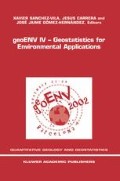Abstract
The estimation of categorical variables is a recurrent problem in geostatistics. Beyond traditional and well-known methods like indicator kriging (IK) or classification, the Bayesian Maximum Entropy (BME) approach offers a new sound theoretical framework for modeling the spatial correlation and for computing estimates for categorical variables. In this paper, we show how the BME approach can be used for estimating a categorical variable by combining multiple sources of information. This methodology is illustrated with a practical example dealing with the estimation of soil drainage classes. Data involved consist in a set of punctual observations and a pre-existing exhaustive soil map. Estimates are obtained with BME using various combinations of the data, i.e., (i) the soil map only, (ii) the punctual observations only, and (iii) both of them. For the latter, the relation between the two data sets is taken into account by the way of a double entry probability table when obtaining the maximum entropy joint distribution. The strong advantages of BME over IK are explained at the light of the results that are obtained. The important case of conflicting informations is also discussed at the light of the way BME merges these information.
Access this chapter
Tax calculation will be finalised at checkout
Purchases are for personal use only
Preview
Unable to display preview. Download preview PDF.
References
Bierkens, M.F.P. and P.A. Burrough (1993a). The indicator approach to categorical soil data. 1. theory. Journal of Soil Science, 44(2):361–368.
Bierkens, M.F.P. and P.A. Burrough (1993b). The indicator approach to categorical soil data. 2. application to mapping and land-use suitability analysis. Journal of Soil Science, 44(2):369–381.
Bogaert, P. (2002). Spatial prediction of categorical variables: the Bayesian Maximum Entropy approach. To appear in Stoch. Env. Res. Risk A.
Bogaert, P. and D. D’Or (2002). Spatial prediction of categorical variables: the BME approach. GeoEnv IV.
Bregt, A.K., J.J. Stoorvogel, J. Bouma, and A. Stein (1992). Mapping ordinal data in soil survey — a costa-rican example. Soil Sci. Soc. Am. J., 56(2):525–531, 1992.
Christakos, G. (2000). Modern Spatiotemporal Geostatistics. Oxford University Press, New York.
Christakos, G., P. Bogaert, and M.L. Serre (2002). Temporal GIS. Springer-Verlag, New York.
D’Or D., Bogaert P. and G. Christakos (2001). Application of the BME Approach to Soil Texture Mapping. Stoch. Env. Res. Risk A. 15(1):87–100.
Goovaerts, P. (1997). Geostatistics for Natural Resources Evaluation. Oxford University Press, New York.
Journel, A.G. (1983). Nonparametric estimation of spatial distributions. Mathematical Geology, 15:445–468.
Journel, A.G. (1986). Constrained interpolation and qualitative information — the soft kriging approach. Mathematical Geology, 18:269–86.
Kullback, S. and R.A. Leibler (1951). On information and sufficiency. Annals of Mathematical Statistics, 22:76–86.
Van Orshoven, J., J. Maes, H. Vereecken, J. Feyen, and R. Dudal (1988). A structured database of Belgian soil profile data. Pedologie. 38:191–206.
Author information
Authors and Affiliations
Editor information
Editors and Affiliations
Rights and permissions
Copyright information
© 2004 Kluwer Academic Publishers
About this paper
Cite this paper
D’Or, D., Bogaert, P. (2004). Combining Categorical Information with the Bayesian Maximum Entropy Approach. In: Sanchez-Vila, X., Carrera, J., Gómez-Hernández, J.J. (eds) geoENV IV — Geostatistics for Environmental Applications. Quantitative Geology and Geostatistics, vol 13. Springer, Dordrecht. https://doi.org/10.1007/1-4020-2115-1_25
Download citation
DOI: https://doi.org/10.1007/1-4020-2115-1_25
Publisher Name: Springer, Dordrecht
Print ISBN: 978-1-4020-2007-0
Online ISBN: 978-1-4020-2115-2
eBook Packages: Springer Book Archive

